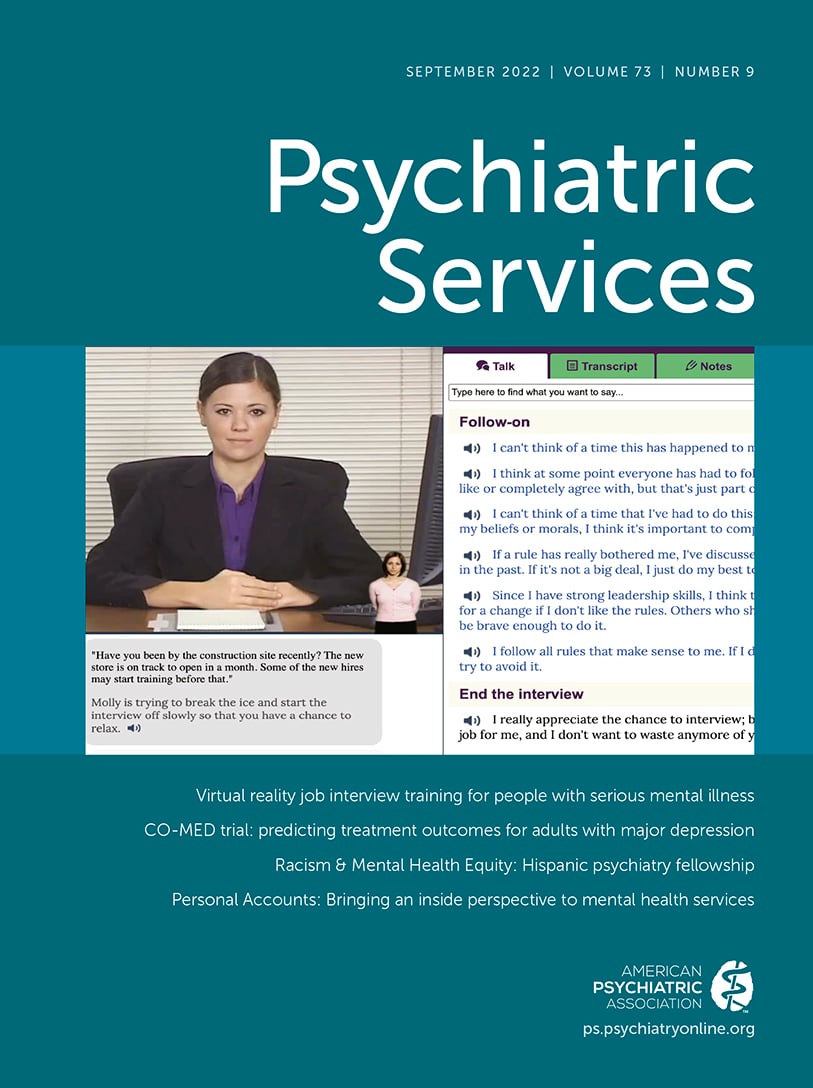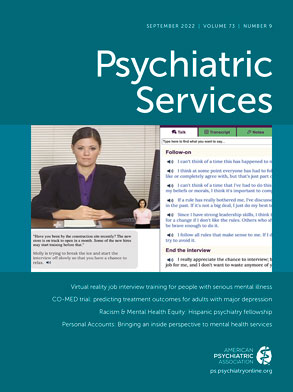In the United States, suicide is the second leading cause of death for people ages 15–24 years and accounted for 5,954 deaths in this age group in 2019 (
1). In a nationally representative sample of emergency departments (EDs) in 2020, approximately 95,000 adolescents ages 14–18 years presented to EDs for self-harm injuries (
2). From 2006 to 2011, although all-cause hospitalizations for children ages 10–14 years did not increase, ED visits for behavioral health conditions increased by 21%, and hospitalizations for behavioral health conditions increased by approximately 50% (
3). Child and adolescent patients who seek ED care because of a behavioral health crisis have a longer length of stay (LOS) in the ED than patients presenting with nonbehavioral health symptoms, and patients with behavioral health problems have increased rates of boarding either in the ED or in a pediatrics unit while awaiting an open bed in a psychiatric unit (
4,
5). Both longer LOS and boarding lead to increased resource demand on EDs (
6).
Methods
From October 10, 2018, to January 19, 2020, we conducted a cross-sectional online survey in REDCap of pediatric emergency medicine chiefs practicing in North America. Survey participants were recruited via e-mail and informed that their participation was voluntary and unpaid, that survey results would be pooled for presentation, and that no identifying data about the survey participants would be collected. This research was reviewed by the institutional review boards (IRBs) of the New York State Psychiatric Institute and the Department of Psychiatry at Columbia University and found not to meet the definition of human subjects research requiring further IRB review.
Pediatric emergency medicine chiefs (i.e., physician leaders of a pediatric ED) were identified by membership in Pediatric Emergency Medicine North American Chiefs (PEMNAC). The division director of pediatric emergency medicine at Columbia University and PEMNAC member (F.M.S.) had access to the PEMNAC e-mail database and personally sent the survey invitation to potential participants. The database information was not shared with the research team.
The initial survey instrument was adapted from earlier work by Baraff et al. (
7). The survey collected data in the following domains: hospital and setting, patient population, psychiatric evaluations, psychiatric dispositions, LOS in the ED, psychiatric follow-up after discharge, and quality improvement. (The complete survey is available in appendix 1 of an
online supplement to this report.)
We managed all data in REDCap and used IBM SPSS Statistics, version 27, for data analyses. We present descriptive results of the survey. We conducted Fisher’s exact tests to compare the characteristics of survey respondents and nonrespondents, by using information about nonrespondents available in the public domain.
Results
Forty-six (34%) of 136 chiefs of pediatric emergency medicine in North America responded to the survey. All nine U.S. Census divisions were represented in both the responder and nonresponder groups. Three (30%) of 10 Canadian provinces were represented in the responder group. (Supplemental Table 1, available in the
online supplement, presents the pediatric ED characteristics of survey respondents and nonrespondents.)
Respondent hospitals had a mean±SD number of 44,747±24,970 patients per year (median=37,000, range 1,500–100,000 patients). Two of the 46 respondent hospitals did not have a separate pediatric ED; of the 44 pediatric EDs in the sample, the upper age limit for pediatric populations was most frequently 21 (39%, N=17), 18 (25%, N=11), and 17 (11%, N=5) years. A minority of pediatric EDs had upper age limits of 19 or 20 years. Pediatric EDs reported that they treated on average 1,175±1,039 patients (range 30–5,000) with suicidal ideation or suicide attempt per year, representing 2.6% of all visits.
Supplemental Table 2 in the
online supplement outlines which personnel completed evaluations of patients with suicidal ideation. Of the 46 survey respondents, 24 (52%) indicated that social workers completed the evaluation, followed by pediatric emergency medicine physicians (N=18, 39%). In a smaller percentage of hospitals (see Supplemental Table 2 in the
online supplement), crisis management teams, psychiatrists, child and adolescent psychiatric residents, and child and adolescent psychiatry attending physicians completed the assessments.
Most of the respondent chiefs (N=33, 72%) indicated that the psychiatrist made the dispositional decisions for patients with suicidal ideation. Fewer EDs relied on emergency medicine physicians or social workers to make the dispositional decision. Other personnel listed as making this decision included county child crisis services (N=1, 2%), crisis team (N=2, 4%), crisis team in conjunction with the medical director (N=1, 2%), ED mental health crisis evaluator (N=1, 2%), licensed practicing counselor and licensed clinical social worker (N=1, 2%), psychiatric response worker (N=1, 2%), and telepsychiatry provided by a psychiatrist (N=1, 2%).
Most respondent chiefs (N=33, 72%) indicated that patients were discharged home only after completion of a psychiatric evaluation. Thirteen chiefs (28%) described discharging home patients without a psychiatric evaluation. Among these respondents, the most frequent criteria cited to discharge a patient without a psychiatric evaluation were the patient not being currently suicidal (N=11, 85%), close monitoring by an adult until follow-up (N=9, 69%), no recent history of suicide attempt (N=8, 62%), and preparation of a “no-suicide contract” (N=8, 62%). Overall, 31% (N=4) of the chiefs reported no specific criteria for discharge.
Most respondent chiefs (N=36, 78%) stated they had no standardized clinical pathway for the dispositional decision for pediatric patients with suicidal ideation or suicide attempt. If a medically stable pediatric patient with suicidal ideation or suicide attempt required psychiatric admission, 42 respondents (91%) indicated transferring the patient to an outside psychiatric facility, 19 (41%) admitted the patient to their own hospital’s psychiatric service, and 18 (39%) admitted patients to their own hospital’s medical service. The LOS in the pediatric ED for pediatric patients requiring psychiatric admission was 18.0±13.6 hours, longer than the 7.4±4.9 hours for pediatric patients with suicidal ideation or suicide attempt who were discharged home.
Patients with suicidal ideation or suicide attempt who were discharged were most frequently referred to community mental health clinics (N=39, 85%), a hospital-based mental health clinic (N=26, 57%), home-based interventions (N=20, 44%), mobile crisis teams (N=20, 44%), or their pediatrician (N=23, 50%). (Patients could be referred to more than one treatment setting.) Only a minority of the chiefs (N=13, 28%) reported routinely following up with discharged patients to ensure an appointment was made with one of the referrals. Most hospitals (N=38, 83%) reported having a resource list of mental health clinics available for ED physicians to provide to pediatric patients with suicidal ideation or suicide attempt.
Table 1 outlines the improvements the pediatric emergency medicine chiefs reported they would like to see in the care for patients with suicidal ideation or suicide attempt. The most frequent improvements, selected from choices on the survey, were improved access to mental health personnel for patient evaluations (70%) and for dispositional planning (70%). Moreover, 20% of the respondents indicated other improvements they would like to see in the care of patients with suicidal ideation or suicide attempt. These changes included appropriate dedicated safe spaces in the ED for the patient evaluation (N=2, 4%), internal psychiatry inpatient units to obviate the need to transfer patients to outside hospitals (N=1, 2%), increased inpatient and outpatient treatment options (N=1, 2%), increased follow-up for patients discharged home (N=1, 2%), a pediatric crisis center external to the ED for patients not necessitating medical work-up (N=1, 2%), and 24/7 in-person child and adolescent psychiatry ED coverage (N=1, 2%).
Discussion
In this study, visits to the pediatric ED for suicidal ideation or suicide attempt represented 2.6% of all visits, consistent with findings in previous studies (
8). Although accounting only for a seemingly small percentage of the total pediatric ED visits, children and adolescents presenting with suicidal ideation or suicide attempt require substantial resources in the form of consultation services, restraints, laboratory tests, and relatively long LOS (
6).
Many chiefs of pediatric EDs stated that their community was severely lacking resources for referring pediatric patients with suicidal ideation or suicide attempt to psychiatric outpatient care. Creative solutions exist to address these gaps in care. One such example is an emergency mobile psychiatric service (EMPS) led by Connecticut Children’s Medical Center (
9). EMPS responds directly to patients in crisis in their home or school or in an ED and connects patients to follow-up care within 45 hours. The cost of an EMPS consultation is $842, compared with >$10,000 for an inpatient psychiatric admission, indicating that this system of care is cost-effective, both decreasing the burden of ED visits on the patient, family, and ED and connecting patients directly to the outpatient services needed.
Only a minority of the 46 hospitals routinely followed up with discharged patients to ensure an appointment was made with one of the referrals. One multisite study in adult EDs of patients ages ≥18 years who had suicide-related problems showed that safety plan intervention in the ED and follow-up telephone contact after discharge were associated with nearly half the odds of suicidal behavior over the next 6 months and double the odds of attending at least one outpatient mental health visit (
10). This finding suggests that similar practices for patients presenting to the pediatric ED with suicidal ideation or suicide attempt who are discharged home may decrease future suicidal behavior and may increase the odds of adherence to outpatient mental health follow-up. As such, a safety planning intervention—an empirically based effective practice—should be employed rather than “no-suicide contracts,” which have no empirical support for clinical effectiveness (
11). Of note, 17% of the respondent chiefs reported that they discharged patients with a no-suicide contract but without a psychiatric evaluation, indicating a need for training ED personnel in appropriate suicide risk assessment and management practices.
A major limitation of this study was the low survey response rate (34%), but we had publicly available demographic data on the nonrespondents to compare the characteristics of respondents and nonrespondents. The responding sites in our study were overwhelmingly urban centers with separate pediatric EDs, similarly to nonresponding hospitals. This similarity suggests that our sample can be generalized to hospitals in urban settings with separate pediatric EDs. Both responder and nonresponder groups included all nine census regions in the United States, indicating that responder and nonresponder groups had similar geographic distributions. Another limitation of our study was that further attempts to increase the response rate were curtailed by the COVID-19 pandemic. We hypothesized that survey responses before the pandemic might differ from those during the pandemic and that continued data collection during the pandemic period may confound results. Therefore, data collection was halted in January 2020. Finally, the survey responses were characterized as the respondents’ estimates and were not collected through a mandatory review of electronic medical records. We also note possible recall bias and variation in knowledge of ED operations among the chiefs surveyed. Nevertheless, we are confident that the chiefs surveyed for our study provided their best estimates of the patient volume, percentages of personnel completing evaluations, and LOS data.

